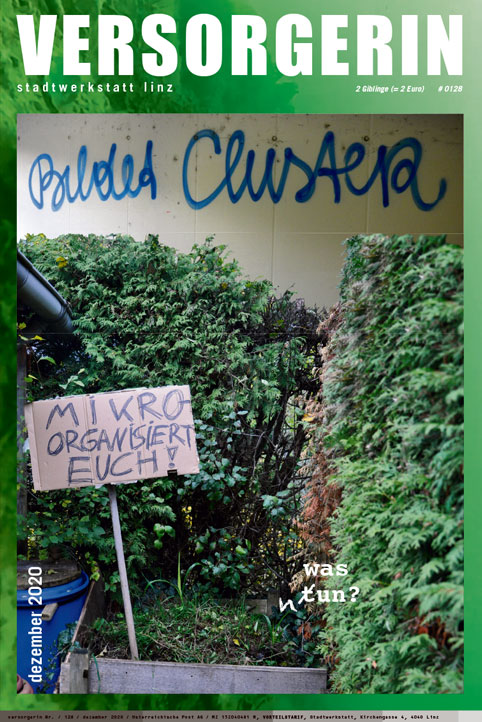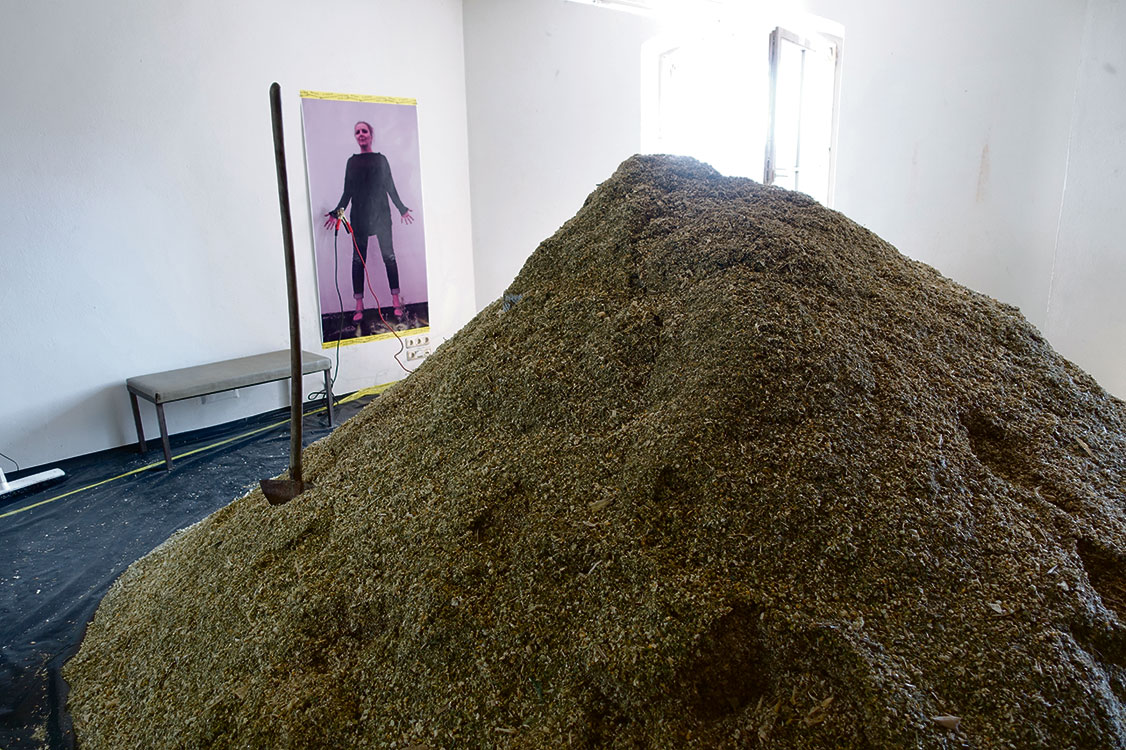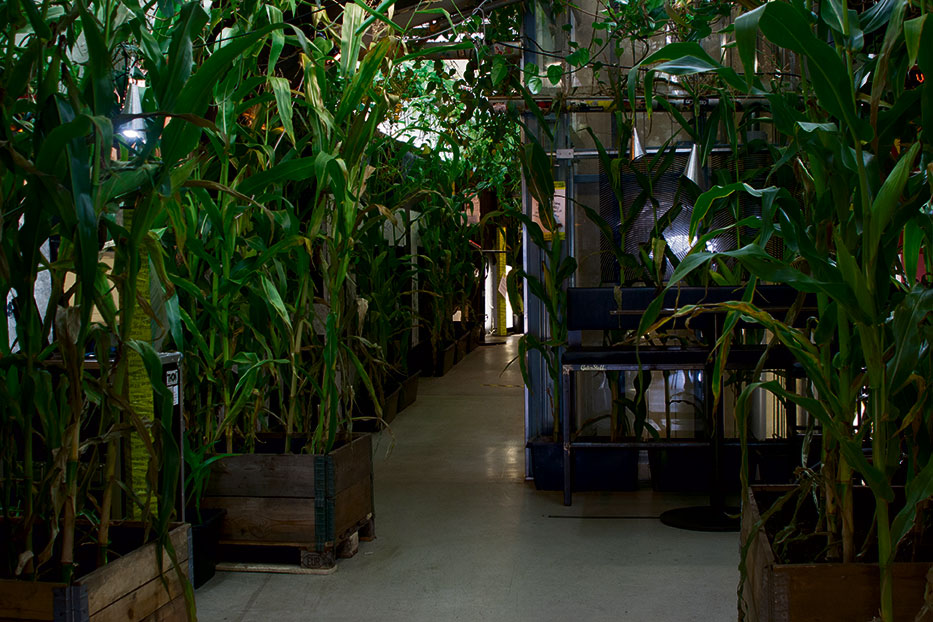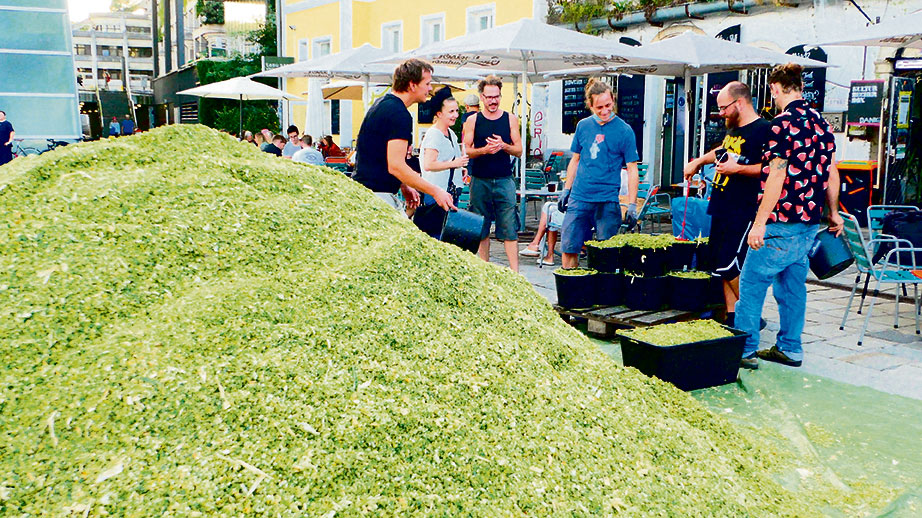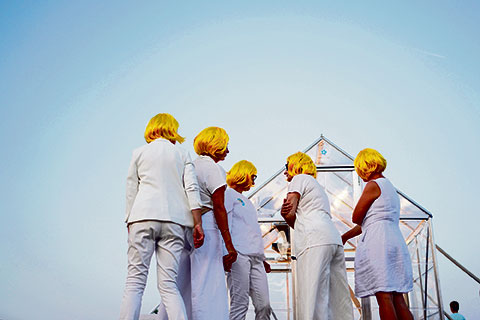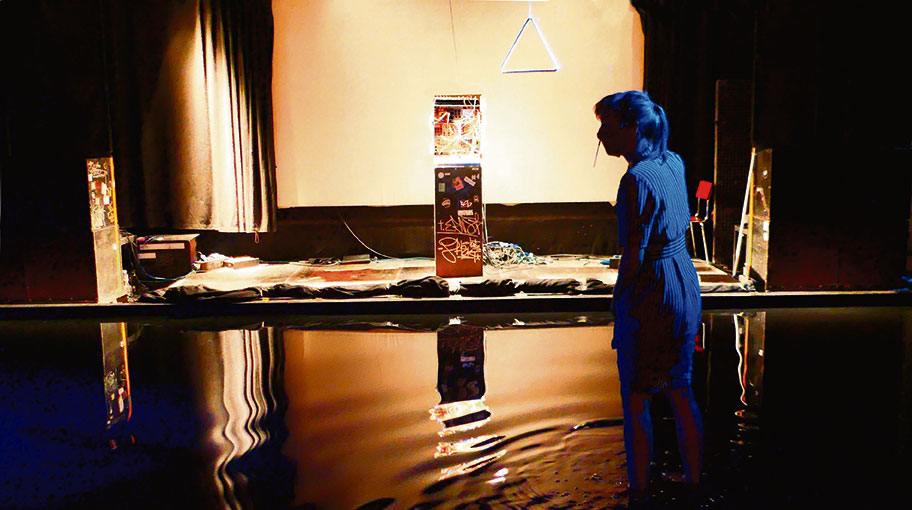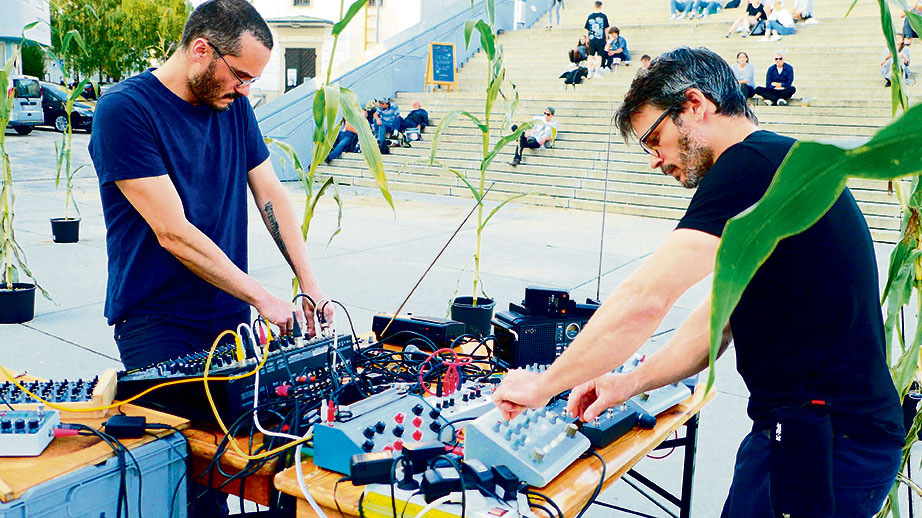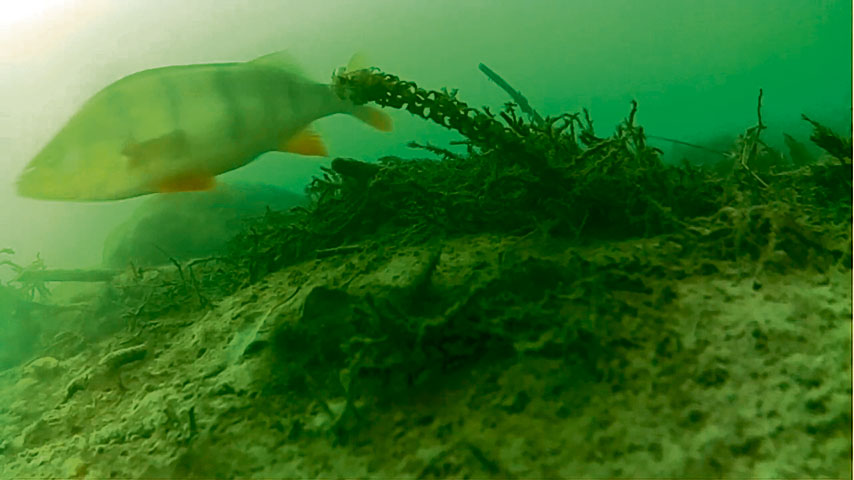»Off of the off« or »off very in« Ars Electronica, the annual 48-hour extravaganza hosted by Stadtwerkstatt counter-cultural center for the past six years has become a shelter for those who
forsake the mundane. Makery met Tanja Brandmayr and Franz Xaver, who work every day on
fostering its unique spirit.
For many people, going to the Ars Electronica festival in Linz in September means attending exhibitions and talks, networking and self-promoting, questioning the relevance of the awards and the loud outdoor installations, loving or hating the gala evening. But for the past six years, it has also been an opportunity for people to spend 48 hours in the historic Stadtwerkstatt cultural center next to the Ars Electronica Center in the Alt-Urfahr district on the Danube. For two days, anyone can enjoy a drink, a meal, meet new people, join discussions, excursions or workshops, see installations, performances or listen to music. For its 6th edition in this pandemic year, the 48-hour extravaganza program curated by Stadtwerkstatt in collaboration with the artist Shu Lea Cheang (who also co-initiated STWST48 in 2015 and has been part of the STWST curatorial/production team ever since), the theme was »More or Less«.
On the 48h website, Stadtwerkstatt »asks questions about the more-or-less situations, the non-equality areas, the counter-validity zones and the non-zero-sum games of the future. In the middle of a new nothing we build up a scenery between MORE and LESS to distribute critical contents, artists and critical producers to negotiate conditions that make a difference.« After visiting several times in the past, Makery was happy to see that, despite the »don’t come« recommendation of Ars Electronica Festival 2020, the 48h extravaganza was still going as planned in Linz. On our way to the Schmiede festival in Hallein, we couldn’t resist the detour, with one question in mind: How do they stay alive and kicking in this epicenter of alternative culture in Linz during these Corona times? Tanja Brandmayr and Franz Xaver responded.
Can you tell us a bit about STWST’s history and when you personally joined the project?
Tanja Brandmayr: STWST is 40 years old (we celebrated last year). It started out as an autonomous space, driven by the young artists’ scene in 1979. Art and media were the relevant part from the beginning, especially as the early media art projects of the 80s and 90s became well known, also many other projects. But from the very beginning it was a very mixed scene, with a strong social aspect. Now there are books on it — art and chaos in 1982, or whatever (laughs). Speaking about the social aspect, for example, some women came in, seeking shelter to escape from their violent husbands and fathers. The neighborhood of STWST was very conservative at that time. STWST became famous early in its history because of its art projects and their social dimension.
Franz Xaver: I have been a part of STWST for the last 10 years. We started the boat Eleonore at the same time. We bought the boat for a symbolic euro on Ebay. The project was to invite international artists in residency during the summer. This year we exhibit 10 years of activities. It is a place where we can talk together. The boat had to be moved recently to a new location, in the backwater area of the Traun-Danube estuary. I did a lot of technical and radio art in the past, from shortwave to microwave, every kind of waves were involved in my work. Short waves work very well in the new location of Eleonore, maybe because of the electromagnetic fields nearby. Using a WSPR beacon that I made, we’re reaching Australia, New Zealand with 0.5v. It’s a 40m band, 7 MHz. We’re also in contact with the Stubnitz on a very small band, the bandwidth is 6 Hz. We also transmit through a standard satellite TV dish.
Tanja Brandmayr: I have been working constantly for the magazine ‘Versorgerin’ since 2008, and I had some connections through art projects. I became a board member in 2014, and as an artist I could develop my own research field called Quasikunst over the following years. All in all, I love working here because we have many influences coming in: of course the ones from our New Art Contexts, and with the night situation, the club scene, we also know a lot about the social problems which only come out at night, when you are very directly in contact with them. We also have this extension of the art storage space for the past three years. It’s a very big building that we had the chance to get for cheap, where we do a lot of rework of all these archives, although we lack the money to make a big work, but we do it constantly. It’s really impressive to see these relics of 40 years of history… It’s not only art and media artists, but also social history, city history, subcultures history. This whole critical mixture, which is still a real and relevant part nowadays.
So this year you put a cornfield on the plaza in front of STWST and the Ars Electronica Center. Can you explain why?
Tanja Brandmayr: As you can see, it has some presence, it’s very visible when you come, from both outside the house and inside the house. It was developed during the Covid situation in March and April, because the whole house, the whole space had been shut down for the music events. Most of us were staying at home, but some were here and keeping some activities going. We began almost from the first moment to come with an idea for using the house differently, how to use the empty house, how to work with this situation of nothingness… and then, we had this idea of the »cathedral of nothingness«, as a working title. So, even if we would need to shut down in September, we could still work with the empty house, and even if we could only allow a limited audience to go in, walking through and coming out, we were very sure we would be able to rock with this situation, to work with this life situation. We did also a lot of planting in springtime, including a bit of corn. We had to deal with this ‘yes-no’ situation, with this idea of ‘let’s call it post-media art’ and so on, this whole question of our nature communicating and informing itself, of how information goes.
Somehow, the idea of planting corn came again when we started to work with the idea of ‘more or less’, ‘Stadtwerkstatt more or less’. We liked this idea of having this image of monotonia, of nature-culture monotonia, as cornfields are very wide, but also very industrial and monotonous. It’s one of the first cultured plants, and we did a lot of research about the history of corn, it’s also a migrating plant that has traveled all over the world. And we very much liked the idea to have nature in the house, but not the wild and romantic one, the very monotonous one, the very exploited one. That was the main idea, and when we told our community about it, everybody said ‘Oh cornfields, my childhood! I went through the corn, and heard the wind, etc.’ So it’s also very emotional for everyone, and that has really surprised me. You lose yourself in a cornfield, it’s totally disorientating, when you are in the middle, when you have to decide which way to go, you have to keep straight ahead, otherwise you never get out of it! (laughs)
Franz Xaver: About the theme ‘More or Less’, for me the problem is that nowadays we have too much information. We cannot put so much information in our brain… The idea is that our content should go ‘down’ and that less information could be more information. It’s very important for the future, because we are all completely overloaded with information. For me, this is the sense of what we did here, with this theme.
But STWST is known for its local radio station and the art and culture server servus.at?
Franz Xaver: I began at STWST with the InfoLab, I was working with information… And now this trend with all these labs, future labs, hacklabs, fablabs, and so on… In the end all these labs are information labs… and what lies in the information is so important… That’s why we try to present ‘no data’ things (laughs). You saw our rooms with all these plants: this is the information of evolution. The information comes from evolution. But yes, we have two radio projects here, and even for them we also try to work with less information. Only a few bits and bytes.
Can you explain the different iterations of the corn—the field, the popcorn house, the silage room with the shredded corn?
Tanja Brandmayr: Here we don’t only invite projects and curate things in a conventional way, we also have a strong focus on production and on this mixture of art and culture and social sphere, that are not especially ‘art’ ideas. It’s a very important point for a community like ours. This is now the 6th edition of STWST 48h, and every year it develops, and I think it works quite well. But this year it was very special, because this whole corn thing became a very strong house project, the expertise of every person who worked here came in a very different way, that’s one reason why I like it so much.
So there are variations which came from the house: we have this ‘going down’ theme as Xav says, and we have again this mycelium theme, that we had for years with the Mycelium Network Society. I personally worked on the fermented corn silage, because I like the idea of staging material that performs by itself, while we do nothing. Some years ago I used a huge block of ice, it melted down, it processed itself. With this fermenting silage, it’s also the theme of processing and fermenting, with bacteria it really processes itself down, and it somehow also connects to this entropy: if we do nothing, it goes down to some stage of itself when no energy comes in. So that’s a part of the whole connection. I made some reflections about this staging of material in earlier projects, the reflection of this year’s context of the fermenting corn silage will follow.
And the popcorn house?
Tanja Brandmayr: It was also a decision to have two projects from associated artists. The »Shirley Tempel« endless popcorn glass house idea came from Freundinnen Der Kunst (female friends of the arts – German wordplay), a feminist collective. They have been working here in town for 20 years, and they are well known in German-speaking countries. They have a series of glass houses performances, which they call Glashausfantasien. I had the idea that there could be some connections, that it could meet what we do with the plants. They took the theme and came up with their thing with the popcorn, which I personally like, because for me popcorn is connected to cinema! And when you talk about nature-culture monotonia, you have also this film industry and this cultural realm that surrounds us.
Tell us a bit more about the concert hall turned into a kind of pool?
Tanja Brandmayr: The idea of the pool came from Nani Cooper and Andreas Ullrich. This is a project that came in from outside. It also came very late, but it’s very good we could discuss after we had decided to fill the house with plants. We liked the idea of proposing the opposite: a whole emptiness in the first floor concert room. The project is called The Only Good System and it stands for itself also because of the setting, the huge sound comes from four sides. It matches perfectly for me because we have on the ground floor some kind of ‘more’ with the plants, and then you go up and there you have ‘less’. And so it informs this idea of ‘cathedral of nothingness’ – it is still a working title – but somehow we like the variations in the house of different kinds of natures. Also I like it because this whole set is very central but not so abstract. I think every project has very abstract and very good research behind it, but somehow we have in this hall a very mixed audience, and for me personally it’s great to see the people coming in for a drink and being attracted to something that catches them in a very immediate or direct way, where they don’t have to think ‘What should we think of this project?’ It makes sound, it smells, it’s very direct, and so I think it’s some kind of attraction, especially in these times with so much streaming and digital screens.
So you worked more locally this time?
Tanja Brandmayr: Well, we always worked internationally, and there was no question of not doing it. So we still launched an open call, but it’s true that the program has a little to do with the Corona situation because we cannot fly people in from far away. And since we planned it in April and May and nobody knew what would happen in summer, the final program is very pragmatic in some way. In the art circles we still see the same people circulating, but what you want to see when you are in a city is what happens in the city.
So, some things are possible. You didn’t say »don’t come, it’s gonna be online« like the Ars Electronica »gardens«?
Tanja Brandmayr: For me it’s very cool, maybe the opposite of the big institutions, to have direct contact with people and artists, and it happens better when people are here. You can also talk directly. We live in direct contact. For example, cooking food together is a very strong social builder. I remember three years ago when we had this »sleep« theme. We made contacts four months before the 48h with the medical center of Kepler University, and a very nice doctor started to come to STWST every month, we also had dinners with him, he explained to us what he was working on scientifically, we told him what we were interested in artistically and all this complex of unconsciousness, and he still visits us today.
Franz Xaver: Things go differently when you have direct contact. Things are very true when you do it like this.
Tanja Brandmayr: We have one streaming project, streaming from the bottom of the Traun river. It’s very dramatic when you see three fishes coming toward the camera! (laughs)
Franz Xaver: And the images of the immersed webcam at the bottom of the river are sent to a satellite and it transmits them to India, Spitzberg, Antarctica, everywhere, you can receive the images from anywhere in the world.
--------
Der Text wurde im Original gezeichnet mit: »Published 21 September 2020 by la rédaction«
https://www.makery.info/en/2020/09/21/stadtwerkstatt-48h-extravaganza-in-linz-less-is-more/
-------
More on the 6th edition of STWST48: stwst48x6.stwst.at
